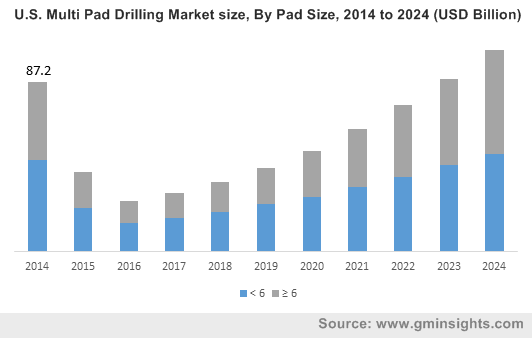Despite global efforts toward a clean energy transition, the multi pad drilling market is forecast to depict considerable growth in the forthcoming years. A majority of this growth is slated to come from the world’s emerging economies, where rising median income levels and energy grid expansion efforts are stimulating a higher demand for energy.
This energy demand may come from the middle-class population worldwide, which has been growing at a steady pace across developing nations. This has, in consequence, fostered infrastructure developments as well as urban migration, which has once again picked up the pace as the world slowly recovers from the coronavirus pandemic.
Over the short term, energy harvested from fossil fuels is still expected to represent a respectable chunk of the energy mix globally. To that end, the world may increasingly turn to multi pad drilling as a viable means of energy production, on account of some of its attractive benefits including lesser environmental impact and enhanced drilling efficiencies.
Meanwhile, the ongoing transformation of the global oil market, which is moving away from ‘burning’ and towards ‘building’ will also shape the multi pad drilling industry outlook over the projected timeline.
According to a Global Market Insights Inc., report, the multi pad drilling market is poised to reach an overall valuation of $180 billion by 2024.
Strong energy demand from developing economies
Driven by the steadily expanding expenditure of the middle-class demographic, the demand for energy across emerging economies is increasing at an unprecedented rate. According to the Pew Charitable Trusts, in the decade preceding the pandemic, middle-class expenditure within developed nations averaged around 0.4%, while that of developing nations averaged approximately 8% annually.
In fact, with approximately 2 billion people across developing countries, the middle-class standard of living is expected to become the norm for a majority of the global populace.
A recent World Data Lab study has estimated that more than 1 billion people in Asia are set to enter the global middle class by the end of 2030, indicating that the pandemic was just a sharp albeit temporary pause experienced by the great demographic shift of the global economy.
These improving living standards would subsequently be fueling the demand for energy, which many of these economies would inadvertently address through fossil fuels. While it would be politically incorrect to say that they would completely overlook green energy sources, the sheer scale of the projected demand means that green sources would be playing a supportive role until an appropriate infrastructure is established. Until that time, conventional sources will continue to cater to energy demands worldwide; in essence, multi pad drilling market trends will continue to proliferate substantially in the years ahead.
Short term growth from ongoing energy security efforts in the West
A number of the world’s leading economies, particularly the ones in Europe and North America, have pledged to expedite the transition of their energy systems to clean, renewable sources. However, to address the issue of dwindling supplies with more urgency, many have been turning back to the traditional fuel sources.
The situation has further been exacerbated by the ongoing conflict and the resulting geopolitical tensions, wherein Europe and North America are actively working to bring their reliance on Russian oil and gas down to zero.
Consequently, to avert an energy crisis that could breed energy poverty, countries are focusing on diversifying their energy imports and ensure optimal energy security. Many are, in fact, preparing to recommence discontinued offshore drilling and exploration operations.
A notable instance is that of the UK, which in February of 2022 indicated that it would not be halting the issuance of new exploration licenses. Instead, the country has stated that new exploration activities would be subject to stringent tests. These conditions are ripe for the growth of the multi-well pad drilling industry.
Meanwhile, towards the end of 2021, Norway, which supplies more than 20% to 25% of the European Union’s overall gas demand, announced that the country would continue the exploration of more oil and gas reserves in the next four years. The Norwegian government has stated that most of the new drilling permits would come in the mature areas of its seas.
The country, similar to its European counterparts, wants to ensure that any transition away from fossil fuels, along with the jobs it generates, towards clean energy is a relatively gradual one, effectively creating more opportunities for the region’s multi pad drilling sector in the short term.
Final Thoughts: Despite the world embarking on a journey toward clean energy sources, the multi pad drilling industry is projected to play a crucial role in the global transition. While the market is slated to witness the rise of new opportunities for novel drilling sites, the overall landscape appears to be getting ready for a major shift away from the conventional ways.
